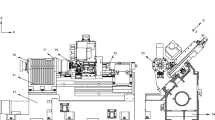Abstract
In flank milling process, machined surface is formed by the edge of the cutting tool while the position of tool is influenced by the movement of computer numerical control (CNC) machining axis and the status of tool is influenced by the cutting force; thus, the quality of the workpiece is affected by multiple error sources. In this paper, a new error prediction method is proposed to integrate errors of the process system, including tool rotation error, machine geometric error, and tool deformation error. All these errors are synthesized to generate the movement of tool edge in the workpiece coordinate system. Then, the machining error is obtained by projecting the point cloud of tool edge to the workpiece normal vector. Case studies are performed at the end, and the influence of tool rotation error on workpiece error is discussed. The model has been validated with an experiment.
Similar content being viewed by others
References
Wang W, Li Y, Ma Y (2013) Towards a feature-based agent-driven NC tool path generation to support design and process changes. Computer-Aided Design and Applications 10(4):603–618
Liu C, Li Y, Wang W, Shen W (2013) A feature-based method for NC machining time estimation. Robot Comput Integr Manuf 29(4):8–14
Liu X, Li Y, Ma S, Lee CH (2015) A tool path generation method for freeform surface machining by introducing the tensor property of machining strip width. Comput Aided Des 66:1–13
Liu C, Li Y, Shen W (2015) Dynamic feature modelling for closed-loop machining process control of complex parts. Int J Comput Integr Manuf 28(7):753–765
Bryan J (1990) International status of thermal error research (1990). CIRP Annals-Manufacturing Technology 39(2):645–656
Ferreira PM, Liu CR (1993) A method for estimating and compensating quasistatic errors of machine tools. Journal of Engineering for Industry 115(1):149–159
Aronson RB (1996) The war against thermal expansion. Manuf Eng 116(6):45
Ibaraki S, Knapp W (2013) Indirect measurement of volumetric accuracy for three-axis and five-axis machine tools: a review. Department of Micro Engineering, Kyoto University; Institute of Machine Tools and Manufacturing (IWF), ETH Zurich
Donmez MA, Blomquist DS, Hocken RJ, Liu CR, Barash MM (1986) A general methodology for machine tool accuracy enhancement by error compensation. Precis Eng 8(4):187–196
Kiridena V, Ferreira PM (1993) Map** the effects of positioning errors on the volumetric accuracy of five-axis CNC machine tools. Int J Mach Tools Manuf 33(3):417–437
Wang C (2000) Laser vector measurement technique for the determination and compensation of volumetric positioning errors. Part I: basic theory. Rev Sci Instrum 71(10):3933–3937
Janeczko J, Griffin B, Wang C (2000) Laser vector measurement technique for the determination and compensation of volumetric position errors. Part II: experimental verification. Rev Sci Instrum 71(10):3938–3941
Zhang H, Yang J, Zhang Y, Shen J, Wang C (2011) Measurement and compensation for volumetric positioning errors of CNC machine tools considering thermal effect. Int J Adv Manuf Technol 55(1–4):275–283
He Z, Fu J, Yao X, & Qian W (2010) Volumetric error identification for CNC machine tool based on multi-body system and vector diagonal measurement. In Mechanic Automation and Control Engineering (MACE), 2010 International Conference on (pp. 3345–3349). IEEE.
Association, J. S. . Test condition for machining centers—part 6: accuracy of feeds, speeds and interpolations
Association, J. S. Test condition for machining centers—part 1: geometric tests for machines with horizontal spindle and with accessory heads (horizontal z-axis).
Association, J. S. Test condition for machining centers—part 2: Geometrictests for machines with vertical rotary axis (vertical Z-axis) (horizontal Z-axis)
Association, J. S. Test conditions for machining centers - part 3: geometric tests for machines with integral indexable or continuous universal heads (vertical z-axis).
Association, J. S. Test condition for machining centers—part 1: geometric tests for machines with horizontal spindle and with accessory heads (horizontal z-axis).
Yao XH, Jian-Zhong FU, Chen ZC (2008) Bayesian networks modeling for thermal error of numerical control machine tools. Journal of Zhejiang University-SCIENCE A 9(11):1524–1530
Kilic ZM, Altintas Y (2012) Stability of peripheral milling operations with long end mills. Procedia CIRP 4:103–108
Zhang K, Yuen A, Altintas Y (2013) Pre-compensation of contour errors in five-axis CNC machine tools. Int J Mach Tools Manuf 74:1–11
Tuysuz O, Altintas Y, Feng HY (2013) Prediction of cutting forces in three and five-axis ball-end milling with tool indentation effect. Int J Mach Tools Manuf 66:66–81
Bi YB, Cheng QL, Dong HY, Ke YL (2009) Machining distortion prediction of aerospace monolithic components. Journal of Zhejiang University SCIENCE A 10(5):661–668
Yu L, Wang Y, ** Y (2013) Envelope surface formed by cutting edge under runout error in five-axis flank milling. Int J Adv Manuf Technol 69(1–4):543–553
Arizmendi M, Fernández J, Gil A, Veiga F (2010) Identification of tool parallel axis offset through the analysis of the topography of surfaces machined by peripheral milling. Int J Mach Tools Manuf 50(12):1097–1114
Arizmendi M, Fernández J, Gil A, Veiga F (2009) Effect of tool setting error on the topography of surfaces machined by peripheral milling. International Journal of Machine Tools & Manufacture 49(1):36–52
Arizmendi M, Fernández J, Veiga F, Gil A (2010) Model for the prediction of heterogeneity bands in the topography of surfaces machined by peripheral milling considering tool runout. International Journal of Machine Tools & Manufacture 50(1):51–64
Diez E, Perez H, Guzman M, Vizan A (2013) An improved methodology for the experimental evaluation of tool runout in peripheral milling. Int J Adv Manuf Technol 65(1–4):283–293
Srivastava AK, Veldhuis SC, Elbestawit MA (1995) Modelling geometric and thermal errors in a five-axis CNC machine tool. Int J Mach Tools Manuf 35(9):1321–1337
Altintas Y (2012) Manufacturing automation: metal cutting mechanics, machine tool vibrations, and CNC design. Cambridge university press.
Author information
Authors and Affiliations
Corresponding author
Rights and permissions
About this article
Cite this article
Weixin, H., Cao, Y., Yang, J. et al. An error prediction model of NC machining process considering multiple error sources. Int J Adv Manuf Technol 94, 1689–1698 (2018). https://doi.org/10.1007/s00170-016-9867-7
Received:
Accepted:
Published:
Issue Date:
DOI: https://doi.org/10.1007/s00170-016-9867-7



